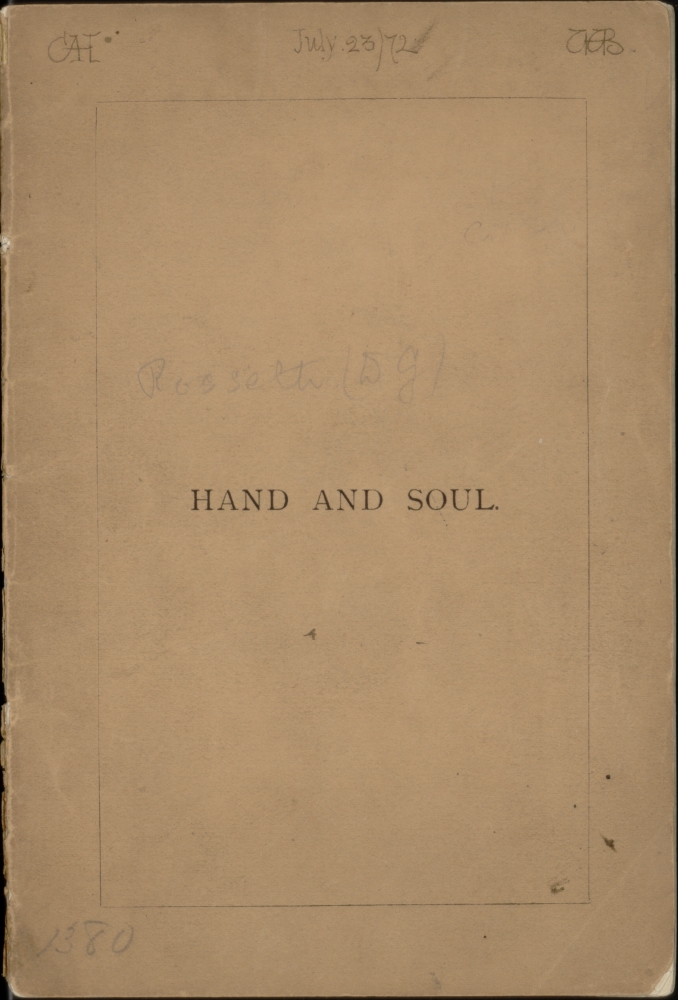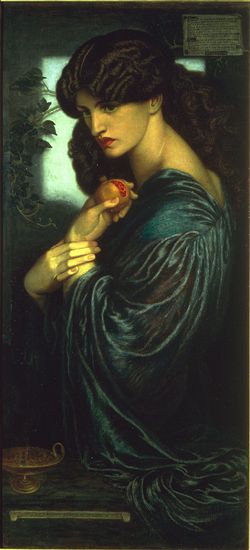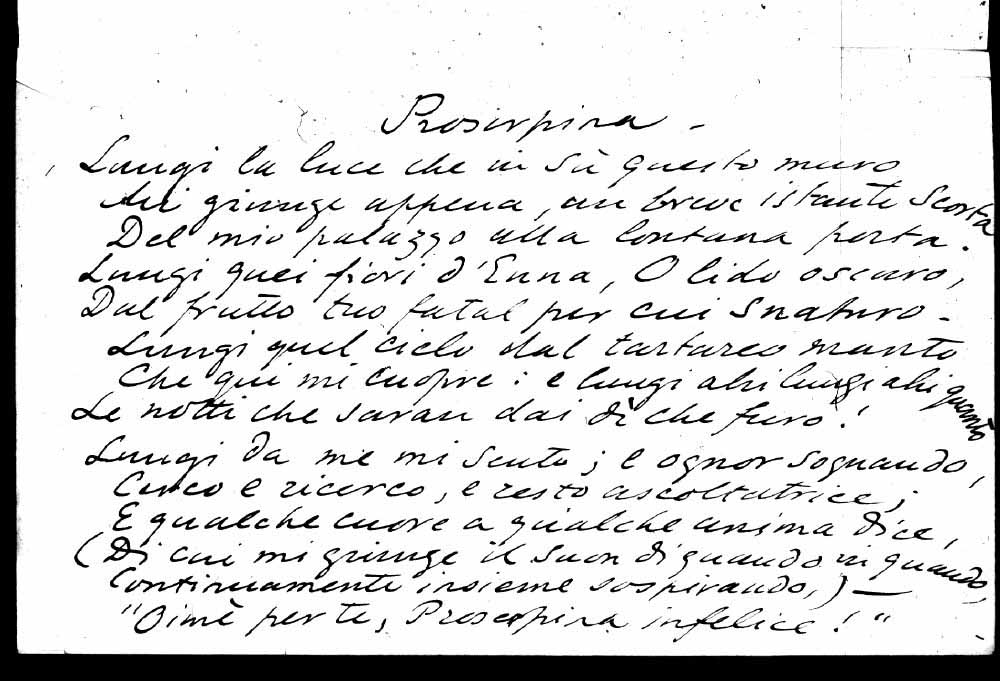An Introduction to D.G. Rossetti
Jerome J. McGann
University of Virginia
Rossetti's characteristic style is well suited to his most famous pair of subjects, Art and Love, where "matter and spirit... play inextricably into each other". Though Pater does not pursue the thought, both subjects are best taken up as activities, in performative and, finally, in interactive ways. The blending of the material and the spiritual, of soul and body, of idea and act, defines Rossetti's pictorial work as much as it does his verse. A pair of famous lines summarizes Rossetti's position: "Thy soul I know not from thy body, nor/ Thee from myself, neither our love from God." Despite the resolute "fleshliness" of the poetry, Pater astutely calls it "sacramental" because it displays this performative quality. Its extreme idealizations emerge in and through acts of writing, much as the meaning of prayer is an instantiated act of devotion.
One other general characteristic of Rossetti's work is important: his commitment to what he called "fundamental brainwork". Unlike his greatly gifted but undemonstrative sister, Dante Gabriel is driven by programmatic ideas and conceptual goals, as his contemporaries well knew. "Exhaustless invention" is how Ruskin described his pictorial work, which he learned to admire but came to deplore as it kept plunging through its Faustian pursuits. Rossetti holds our attention as we are held by the restless and brilliant Stephen Dedalus, who was - as Stephen tells Mr. Deasy in Ulysses - "A learner rather" than a teacher. So to read or look at Rossetti's work - actions required by both the texts and the pictures - is to enter a demanding intellectual space. Rossetti would break with Ruskin in the mid-1860s over a disagreement about how to manage the inheritance of Venetian art. But he remained to the end primarily Ruskinian (rather than Paterian) in treating art and writing more as a scene of intellectual action rather than reflection.
Rossetti began his career by catalyzing the formation of the Pre-Raphaelite Brotherhood through the force of his ideas and personality, which everyone at the time - even those who were teaching him how to paint, like Madox Brown and Holman Hunt - could not stay or resist. The Germ was his brainchild, and he placed in its first number one of the signal aesthetic documents of the period, his artistic manifesto "Hand and Soul".
|
Modest though it seems, "Hand and Soul" undertakes to overhaul the entire edifice of art history as it was formulated by Vasari and thence handed down to Rossetti's day, and even to our own. The argument with Vasari concentrates on the idea - for Rossetti, the illusion - of progress in the arts. Primitive Italian art undergoes a revisionary reading in the history of Rossetti's Chiaro, who refuses the promise of the coming glories of the Renaissance. A modern incarnation of what Trotsky would later call "the privilege of historical backwardness", Chiaro represents an imaginative resource for the nineteenth-century precisely because of his primitive aesthetic commitments - all those stylistic features that would come to be judged crude and incompetent by later art historians, with their enlightened and progressivist myths of art. |
Crucially important is the fact that Rossetti casts his argument in an imaginative rather than an expository form. His point is that the most incisive explanation of an artistic practice ought to be performative - as it is, for example, in Horace's Ars Poetica, in Pope, in Blake's The Marriage of Heaven and Hell, or in Wilde's dialogues. In this programmatic context three topics emerge as indispensable areas of critical attention. Each is closely related to the others. They are: first, Rossetti's theory and practice of translation; second, his exploration of the so-called "double work of art"; and third, his remarkable understanding of what he called "an inner standing-point" as one of the "motive powers of art".
Rossetti set out his ideas about translation in the Preface to his first published book, The Early Italian Poets (1861), where he calls translation the "most direct form of commentary" and exegesis. It is a thus paradigm example of a performative act of literary criticism. Furthermore, the translator's obligation is to pursue "fidelity" rather than "literality" as his translational goal. So Rossetti's translations tend to be relatively free with respect to semantic literality and relatively strict with respect to metrical imitation. For Rossetti, a prose translation of poetry is no translation at all. A final "fidelity" is measured by this explicit rule: "a good poem shall not be turned into a bad one". The rule follows from Rossetti's basic thought that "the only true motive for putting poetry into a fresh language must be to endow a fresh nation, as far as possible, with one more possession of beauty".
Rossetti sees Dante's La Vita Nuova as a prophetic annunciation of these ideas, and when he translates that work as "The New Life" the translation incarnates the emergence of a new artistic life in the nineteenth-century. Rossetti literally becomes "Dante Rossetti," the resurrected figure of the great Florentine and, as such, the living sign of the deathless character of art. This dynamic is what "Art for Art's sake" signifies for Rossetti. As Dante Alighieri's avatar, he is called to his comprehensive work of translation because, in his view, Dante's writings are the gravitational center of the literary rebirth that took place between the emergence of the Sicilian School and the appearance of Boccaccio and Petrarch.
|
But Rossetti's aesthetic program was not only a literary one. Perhaps his most important aesthetic contribution was that remarkable generic form known as "the double work of art." This is an amalgam of literary and pictorial works on a single subject - two at a minimum, but the number of objects can be and often are multiple: for example, the constellation of pictures and texts named "The Blessed Damozel" or "Proserpina." Rossetti's first important double work, The Girlhood of Mary Virgin, exhibits the form's typical dynamic structure. That is to say, Rossetti usually "doubles" a pictorial work with a text or a set of texts. The picture may be his own or someone else's. In 1849, for example, he wrote a series of outstanding "Sonnets for Pictures" that responded to various paintings he saw on the trip he and Holman Hunt made to Belgium and Paris. The doubling may also proceed in the other direction, however, as when Rossetti "illustrates" his own texts or texts from Poe, Tennyson, or other writers. Rossetti's earliest double works are of this last kind and they clearly derive from the illustrated book tradition. |
|
These double works are translational forms -"direct forms of commentary" and exegesis. The dialectic of the forms is once again performative rather than conceptual. One might judge from this process that Rossetti is pursuing an unmediated form of knowing, but the truth is otherwise. What these double works want to avoid is precisely the transformation of artistic acts into ideated terms, as if thinking were an abstract process of reflection. For Rossetti, on the contrary, the practice of art is a practice of thought more penetrating than expository explanation. The Ideal forms of thinking are not abstract, they are enfleshed, aesthetic: total body experiences, as it were. Knowing by (re)doing. |




